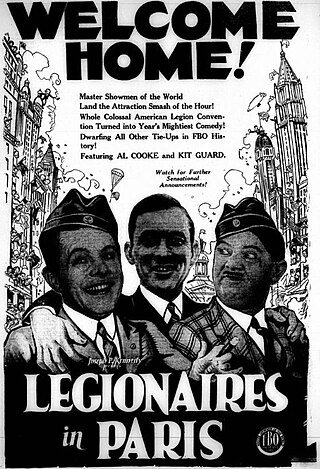
Bray Productions was a pioneering American animation studio that produced several popular cartoons during the years of World War I and the early interwar era, becoming a springboard for several key animators of the 20th century, including the Fleischer brothers, Walter Lantz, Paul Terry, Shamus Culhane and Grim Natwick among others.

Educational Pictures, also known as Educational Film Exchanges, Inc. or Educational Films Corporation of America, was an American film production and film distribution company founded in 1916 by Earle Hammons (1882–1962). Educational primarily distributed short subjects; it is best known for its series of comedies starring Buster Keaton (1934–37) and the earliest screen appearances of Shirley Temple (1932–34). The company ceased production in 1938, and finally closed in 1940 when its film library was sold at auction.

Dorothy Devore was an American silent film actress and comedian.
Phonofilm is an optical sound-on-film system developed by inventors Lee de Forest and Theodore Case in the early 1920s.

Lloyd Vernon Hamilton was an American film comedian, best remembered for his work in the silent era.

Billy West was a silent film actor, producer, and director. Active during the silent film era, he is best known as the premier Charlie Chaplin impersonator. He was a star in his own right, appearing in more than 100 films for nine different companies. Beyond acting, he also directed short comedies in the 1910s and '20s, and produced films. West retired as an actor in 1935, but remained in the employ of Columbia Pictures into the 1950s.

Alice Howell was a silent film comedy actress from New York City. She was the mother of actress Yvonne Howell.

Earle W. Hammons, known professionally as E. W. Hammons, was an American film producer,. He produced more than 220 films between 1921 and 1938.

Lige Conley was an American actor of the silent era. He appeared in 140 films between 1915 and 1938.

Thomas Hayes Hunter was an American film director and producer of the silent era. He directed a total of 34 films between 1912 and 1934.

Edith Dunham Foster was an American educational filmmaker who served as the editor of the Motion Picture Community Bureau, which furnished nearly all of the films seen by American armed forces during World War I.

Please is a 1933 short musical comedy film directed and produced by Arvid E. Gillstrom. It stars Bing Crosby as himself along with Vernon Dent and Mary Kornman.

Legionnaires in Paris is a 1927 American silent romantic comedy film directed by Arvid E. Gillstrom and starring Al Cooke, Kit Guard, and Louise Lorraine. It was also known by the alternative title of French Leave.
Sunshine Comedies is a silent film era line of comedic short films. The two-reel film series was produced by Fox Film beginning in 1916. Actors featured in the series include Slim Summerville, Billie Ritchie, Ethel Teare, and Eli Nadel. Many of the comedies are lost but some survive. They were produced from 1917 until 1925.
The Melancholy Dame is a 1929 American comedy short film by an African-American cast. Al Christie based it on the Octavus Roy Cohen comedy series called "Darktown Birmingham", published in the Saturday Evening Post. Arvid Gillstrom directed it and Evelyn Preer played the title role.

Tuxedo Comedies were a brand of short comedy films in the United States. Comedian Al St. John appeared in and directed many of them after his three years with Fox Film doing Sunshine Comedies. They were produced by Reel Comedies. Educational Pictures distributed.
Cameo Comedies is a brand of short comedy films made in the United States. The films are one-reel shorts from Educational Pictures, usually produced by Jack White, and Colonial Motion Picture Corporation. The Cameo brand was used during the 1924-25 and 1931-32 seasons. Three of the productions utilized 3D stereoscopic effects in the titles. The earlier films were produced for $5,000 each.

Charles Herbert Christie and Alfred Ernest Christie were Canadian motion picture entrepreneurs.

This is a list of known on-screen appearances made by Joe Martin (orangutan), a film star of the 1910s and 1920s.















